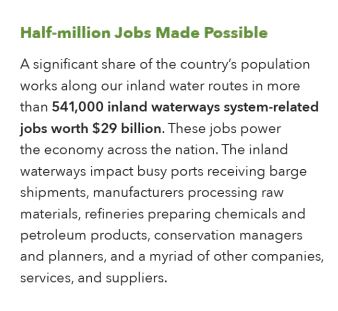Inland Rivers, Ports & Terminals (IRPT) has partnered with the Waterways Council, Inc. (WCI) to promote the economic impact on the Nation’s Inland Waterways. The National Waterways Foundation (NWF) has released waterways profiles for the economic impact of the inland waterways for several states. Profiles can be accessed by clicking on each state above.
ECONOMIC IMPACT OF INLAND RIVERS PORTS AND TERMINALS
Inland Marine Highways, that is, the inland rivers, move commerce to and from 38 states throughout our nation’s heartland; they serve as transport ramps to industrial and agricultural centers; and they facilitate imports and exports at gateway ports on the Coasts. Our nation’s rivers deliver vital goods between major gateway ports, establish new trade networks with significant public benefits and create a foundation for future trade growth.
A multitude of ports and terminals service the inland waterways. The primary focus of our inland ports is to grow our economies by providing an access point for multi and inter modal transport via river, rail and road. An efficient intermodal freight network is vital to both domestic and international commerce of the U.S. and its contributions to the integrated freight network.
Many of the nation’s exports are generated along the inland river system and the imports are destined for locations along or connected to the inland river system via road or rail.

-National Waterways Foundation

In 2019, the U. S. Department of Agriculture releasee a major study on strategic value of inland waterways to U.S. agriculture and U.S. economy. Below is an excerpt from the executive summary.
U.S. farmers have enjoyed a competitive advantage accessing the global export market in larger part due to an effective, robust and resilient infrastructure and transportation network.
Due to its efficiencies and lower costs, the inland waterways system saves between $7 billion and $9 billion annually over the cost of shipping by other modes.
The U.S. economy depends on farmers using the inland waterways system to maintain a competitive position in the global export marketplace, with agricultural exports providing a significant positive contribution to the U.S. balance of trade.
